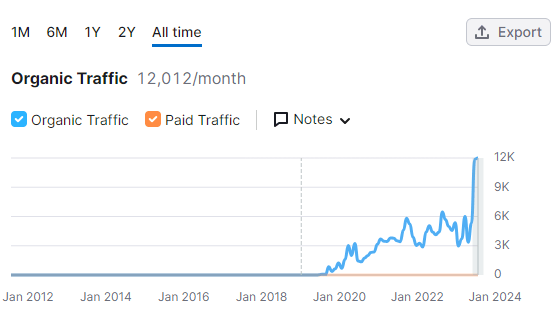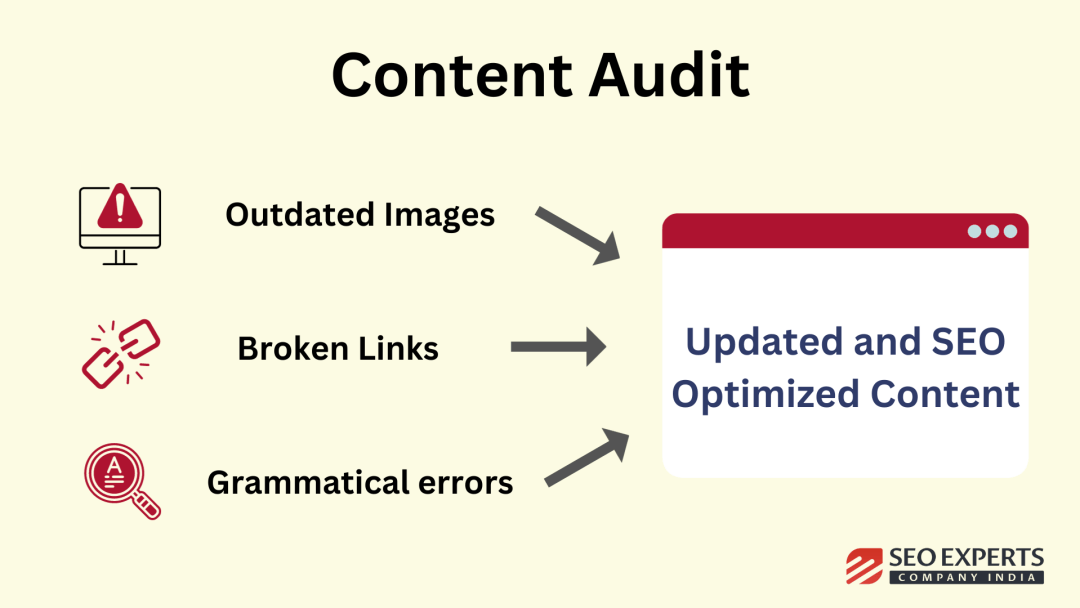Content gap analysis identifies and evaluates the missing content pieces in your SEO strategy. It allows you to fill the gaps and helps discover new content opportunities for your website. Being in the industry for several years, we have come to appreciate the importance of content gap analysis in improving search engine rankings.
In this article, we have shared the core lessons and valuable tips learned through years of refining strategies and working with various clients from different industries.
Keep reading to discover more and master content gap analysis!
What is Content Gap Analysis?
What do you interpret when you read the word “Content Gap Analysis”?
Well, if we are on the same track, your answer should be close to “analyzing some missing pieces in the content.”
Yes, that’s exactly what the Content Gap is!
To brief you further, Content Gap Analysis is the practice of evaluating the current content on your website to discover the “gaps” and missed opportunities in order to improve and outperform your competitors.

For instance, if you run a shoe business and your website doesn’t cover the topic, say, “How to select the correct shoe size,” — this would be a content gap. Content gaps are highly likely to divert your customers to competitor websites to retrieve the information they want.
Why Does Your SEO Strategy Need Content Gap Analysis?
It is essential to carry out content gap analysis because of the following reasons:
- The consumer interests keep shifting.
- Existing information becomes outdated.
- Keywords keep fluctuating.
So, conducting content gap analysis helps your articles perform better, boost engagement, and align the given information with the audience’s interests.
What are the Types of Content Gaps?
Keyword Gaps
Keywords play an essential role in helping the content rank on the first page of search engines. Keyword Gap Analysis involves identifying keywords that your competitors are currently ranking for, and you are not.
Expert Tip: We have learned that incorporating long tail keywords helps the content rank higher as these keywords are less competitive compared to short-tail keywords.
Topic Gaps
Topics are the first thing that comes to mind while thinking about content gaps. Here are the three factors that we suggest you remember while conducting content gap analysis on your topics:
- Ensure that your site covers all the relevant topics.
- The topics on the site should be updated regularly.
- The topics must be relevant to the interest of the readers.
Topic gaps can help you add fresh content to your website and offer a quick way to provide the latest quality content to the target audience.
Media Gaps
Media Gaps refer to the absence of video content on your website. Adding media to your content is important because, according to statistics, 75% of the population prefers to learn about a product or service by watching a video instead of reading about it. So, you can find the media gaps in the content and fix the issue by adding informational videos to the website.
Our Advice on Conducting Content Gap Analysis
Our extensive track record spans over a decade in the industry. During our journey, we have helped numerous clients secure a top spot in the search results. Based on our personal expertise, we are sharing some valuable strategies that will help you bridge your content gaps.
Scan the first page of Google
The best way to find missing topics is to scan and analyze blog posts on Google’s first page. For example, if you want to write an article on “backlink gap analysis,” you should go to Google, type your keyword, and examine the top results on the first page.
We suggest you to pay special attention to the first five results that appear in the SERPs. While analyzing, skim through these articles and analyze all the topics and subtopics that your competitors cover to identify the gaps in your own content.
These gaps can be anything from the “missing latest updates and examples” to “skipped information” and “poor readability.” Fill these content gaps by providing the missing information and updating the article.
Expert Tip: Once you have updated your article with fresh content, don’t forget to edit the publish date to signal to Google that your article is updated. Also, we recommend you to review and update both internal and external links, ensuring they remain current and relevant.
Sharing a recent example that highlights the impact of content gap analysis. Just a while ago, we updated the article ‘Backlink Gap Analysis‘ on our website. With insights from a comprehensive content gap analysis, we pinpointed the areas that needed enhancement and added fresh, valuable details to the blog. Within a mere two days, we observed the article jump from Page #4 to Page #2 of Google.
Perform Content Audits
“Charity begins at home.” Therefore, it’s best to conduct a self content audit in order to acknowledge which of your blog posts are underperforming. Content audits can prove to be a robust strategy when performed within regular intervals. This is because they help you find issues in your current approach and provide solutions for improving future content.
While conducting content audits, we specially focus on analyzing low-quality factors such as grammatical errors, bad English, outdated images, broken links, duplicate content, keyword stuffing, relevancy of anchor text, etc.
Map your Buyer’s Journey
Buyers’ journey is the journey your consumers go through while making a purchase. This journey consists of 5 stages– awareness, consideration, decision, service, and retention.
We believe that mapping the buyer’s journey helps identify and address informational needs at different stages. Your goal must be to create content for each stage of your buyer’s journey, encouraging your customers to make a purchase. By mapping the customer journey, you can know what your customers see, helping you to include new content for them.
Leverage Google Search Console
Google Search Console can be efficiently used to carry out content gap analysis. To do so, you have to follow the simple steps:
- Go to Google Search Console and select “search results” from the sidebar.
- Click on the “+New” and add URLs for your top-performing pages.
- Check keywords that your content has been ranking for.
Next, we suggest you to head over to your website and make sure your content aligns with your top-performing keywords. Once you’ve identified the keywords you rank for that aren’t already covered on your site, it’s time to craft fresh content around them. This approach ensures your website resonates with what your audience is searching for.
Carry Out Keyword Research
Keyword research is a fundamental aspect of optimizing your content for search engines. As part of the content gap analysis process, it helps identify missing keywords that can significantly impact your content’s visibility and relevance.
Once you have found the stronger keywords for your post, you can fill the content gaps by incorporating fresh and updated keywords into your content to increase its quality. Updating old content with fresh keywords further extends its reach and relevance.
There are various keyword research tools available in the market that can help you streamline the research process. We personally use SEMrush, Ahrefs, and Moz for keyword research.
A golden tip that we have learned through our journey is to incorporate LSI keywords. These latent semantic indexing keywords improve content quality and boost search engine visibility. Our experience underscores the effectiveness of this approach in not just closing content gaps but elevating your content’s performance in the search engines.
Run Competitor Analysis
Competitor analysis is the process of evaluating your competitor’s content and SEO strategies to discover the gaps, fruitful opportunities, and topics of interest to your customers. Analyzing your competitors’ content can help you identify gaps in your own content strategy and assist you in creating new, valuable content that your website may have overlooked or not covered comprehensively.
You can use tools like SEMrush to find out which keywords your competitors are ranking for and align these to develop new content ideas for your website.
Let us elaborate the importance of competitor analysis through a recent example of our client in the fitness industry. By conducting competitor analysis and using SEMrush, we identified a gap in their content strategy. We observed that their main competitors had ranking articles about “high-intensity workouts,” but there was a noticeable absence of content on “low-impact exercise routines.”
Capitalizing on this insight, we created a series of engaging blog posts and videos centered around “low-impact exercises.” Within a few months, our client saw a substantial increase in organic traffic from individuals specifically searching for gentle workout options. Not only did this close a content gap, but it also broadened the client’s audience and established them as a go-to source for diverse fitness needs.

Conduct Market Research
Personally, we have learned that combining content gap analysis with meticulous market research is a game-changer. Content gap analysis would not yield any significant results unless and until you know the end goal behind improving your content and recognizing the needs of your target audience.
By collecting insights about the target audience and visitors, you not only identify gaps but also gain an understanding of their interests and search intent.
Use SEO Tools
Tools like SEMrush and Ahrefs are our favorites for conducting content gap analysis. These tools make the process smoother and help discover the right kind of content. When checking competitors, input their website into the tool to find the keywords they’re ranking for. Then, search those keywords on Google to check if big and authoritative sites aren’t already ruling those keywords. If they’re not, consider it a golden chance to bridge the gaps and create content that stands out and gets noticed.
Is Content Gap Analysis an Effective Strategy?
The answer is undoubtedly a big ‘Yes’. Here’s how content gap analysis can help your website and unique blog posts:
- Improves SEO performance.
- Boosts website traffic.
- Better user experience.
- Multiplies social shares.
- Keeps the content updated.
Here’s How We Can Help You in Your Journey
As you are now aware, Content Gap Analysis is a crucial step in a successful digital marketing strategy. Identifying areas where your content falls short in comparison to competitors can significantly improve your online visibility and engagement.
Overall, content gap analysis is a never-ending process that needs to be conducted at least once a quarter to reap the ultimate SEO benefits. However, using content gap analysis services (like ours) is an excellent option to save you time, effort, and trouble.
Our team of experienced individuals goes above and beyond to analyze your website’s overall content and further check if it aligns with the customer buying journey.
At SEO Experts Company India, we help to bridge the content gaps for your website by providing the following services:
- Content Audit: We perform a thorough content audit to evaluate the quality, relevance, and performance of the content.
- Competitor Analysis: We analyze your competitors’ content strategies to identify gaps and opportunities for improvement. We use tools like SEMrush and Ahrefs to conduct competitor analysis.
- Content Mapping: We map your content by keeping the buyer’s journey in consideration, irrespective of the stage of their purchasing journey.
- Keyword Research: We perform dedicated keyword research to discover relevant and trending keywords to compose informational content that resonates with the visitors.
- Performance Analysis: We evaluate how each piece of content performs in terms of engagement, traffic, and conversions in order to assess the underperforming content.
- Regular Reporting: We provide detailed reports to our clients on a regular basis to showcase the progress in filling the content gaps and improving SEO performance. These reports also shed light on newly discovered keywords and topic opportunities.
Let us help you fill your content gaps by providing tailored strategies for growth and increased visibility.
Contact us at the earliest to learn more about our services.







